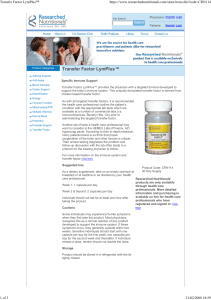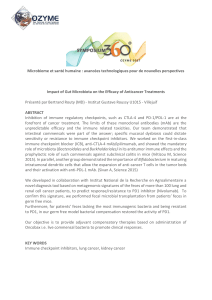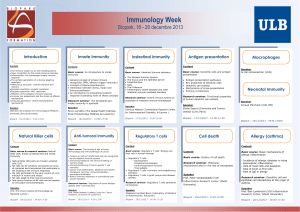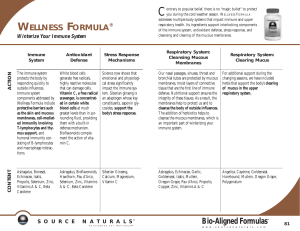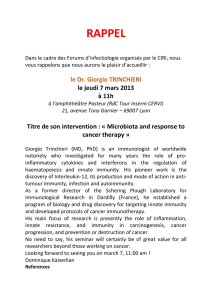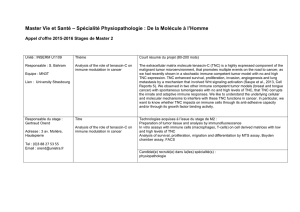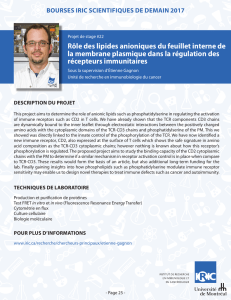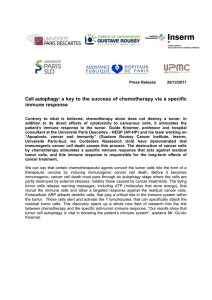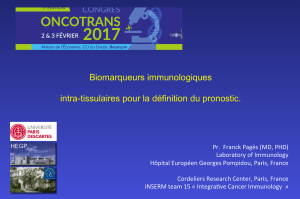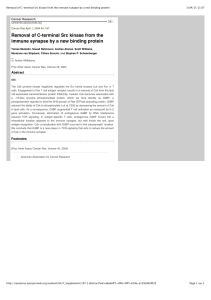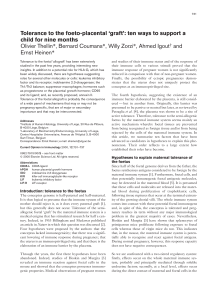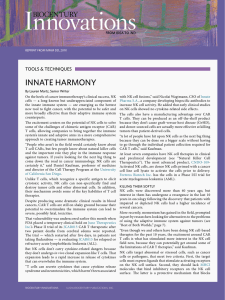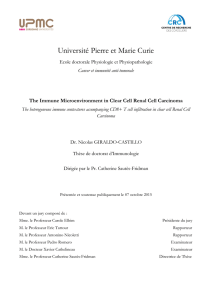CANCER AND IMMUNITY REVISITED THROUGH COSIGNALS
publicité
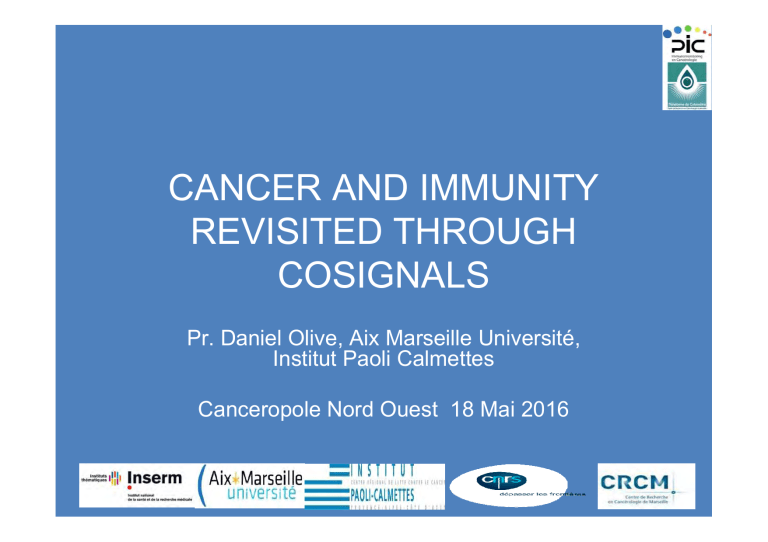
CANCER AND IMMUNITY REVISITED THROUGH COSIGNALS Pr. Daniel Olive, Aix Marseille Université, Institut Paoli Calmettes Canceropole Nord Ouest 18 Mai 2016 disclosures • Founder and shareholder of Imcheck Therapeutics • Research grants from GSK, Innate Pharma, Genentech, Servier • Patents licensed to GSK and Janssen 1. Cancer : Transcriptome, IHC, Deep sequencing, RNA Seq TAA and TSA typing heterogeneity HLA typing Preexisting immune response 2. Exogenous Immunisation Peptides Proteins Viral vectors DNA anti CD mAb fused to TSA or TAA + adjuvant 4. Combo personalized medicine 3. Endogenous Immunisation 4.1 Immunosuppressive mechanisms Chemo Cosignaling, galectins, enzymes IDO Rx and others, Tregs, MDSC… Oncolytic viruses 4.2 Costimulation Therapeutic Mabs 5. Monitoring CARs, transfected TcR PFS Immune parameters (FCM, transcriptome, RNAseq cytométrie transcriptome Blaise, D. & Olive D. , Cancer Vaccines, 2014 ARNseq Objectives Hallmarks of cancer revisited Scientific history Immune system: T cells, Ab for beginners Microenvironments and ways to modify them (Tom Gajewski) The cancer immunity circle (Ira Mellmann) Costimulation, cosignaling Classical cosignalling 1 Anti-CTLA-4 Classical cosignalling 2 Anti-PD1 and anti-PDL1 Other cosignaling molecules involved in both adaptive and innate immunity (TIGIT, CD94, BTLA) • Additional classes 1 ICOS • • • • • • • • • Hanahan and Weinberg, Cell, 2000 2011 Objectives Hallmarks of cancer revisited Scientific history Immune system: T cells, Ab for beginners Microenvironments and ways to modify them (Tom Gajewski) The cancer immunity circle (Ira Mellmann) Costimulation, cosignaling Classical cosignalling 1 Anti-CTLA-4 Classical cosignalling 2 Anti-PD1 and anti-PDL1 Other cosignaling molecules involved in both adaptive and innate immunity (TIGIT, CD94, BTLA) • Additional classes 1 ICOS • • • • • • • • • Introduction “Though many lay unburied, birds and beasts would not touch them, or died after tasting them. The bodies of dying men lay one upon the other [But] those who had recovered from the disease had now no fear for themselves; for the same man was never attacked twicenever at least fatally.” Thucydides, History of the Peloponnesian War 431–428 B.C. The concept of immunity (from the Latin immunitas for “freedom from service”) had been recognized by the great historian Thucydides almost 2500 years ago Cancer Immunosurveillance R. Virchoff, leukocyte infiltration of tumors 1863 P. Ehrlich, modifications of cells might make them recognized and eliminated by the immune system, 1909 Definition of the cellular components necessary for allogenic tumor rejection Tumor Specific Antigens (Medawar 1950) Tumor Associated Antigens are involved in the tumor rejection (1957-59) Foley, Prehn & Main, Old, Klein Mac Farlane Burnet, Immunosurveillance, 1957 Cancer Immunosurveillance JF Miller, identification of the role of the thymus 1961 JF Miller then proposed existence of two major subsets of lymphocytes, 1967 Denomination of B and T (Brook Lodge meeting 1968) :first and last letters of bullshit B cell Hybridoma generation Cesar Milstein and Georges JF Kohler in 1975 Development of the first anti-CD3 mAb OKT3 (Ortho Biotech) in 1979 by P.Kung and G. Goldstein Cancer Immunosurveillance 1973 Stutman, no increased incidence of tumors in nude mice 1975 discovery of NK cells (R. Kiessling) 1998 increased incidence of spontaneous and induced tumors in mice deficient in IFNg response, RAG2-/-, IL-12 p40, TCR b et d, perforin, CD1d KO, NKG2D…(Schreiber et al., Smyth et al. ) Evidences of immune control and identification of immune targets in cancer patients Molecular definition of Tumor associated antigens P. van der Bruggen et al.,Science. 1991 Antibodies directed against TAA in patients U. Sahin et al., Proc Natl Acad Sci U S A. 1995. Clinical trials: M. Marchand et al., Int J Cancer. 1995 ; Tumor regression responses in melanoma patients treated with a peptide encoded by gene MAGE-3. Better prognosis of patients with epithelial ovarian cancer and intratumoral T cells, (Zhang et al., NEJM, 2003, Georges Coukos) . Extended to memory T cells in colon cancer (Pages et al. , NEJM, 2005 ; Science 2006, Jérome Galon) Evidences of immune control and identification of immune targets in cancer patients Immune signature associated to better prognosis with an extension to B cells and Tfh (Bindea et al., Immunity, 2013) T cell inflamed phenotype associated to better prognosis and response to therapeutic vaccine and anti-CTLA-4 (Gajewski TF et al. J. Clin. Oncol., 2009; Louahed J et al., J.Clin.oncol., 2008; Hamid O. et al. , J. Transl. Med., 2011). Type I IFN is associated with a T cell infiltrate (Fuentes MB, J. Exp.Med., 2011) Role of of suppressive mechanisms involving Treg, B, myeloid cells, cosignaling molecules (Dong et al., Nat. Med., 2002), IDO Adaptive immunity T cells therapy induces cancer control after depletion of the immune cells (Dudley, Science, 2002) T cells engineered to express a TcR against TAA are able to persist and control cancer (Morgan et al. , Science, 2006) T cells engineered to express a chimeric antigen receptor against CD19 are able to persist and control CLL (Porter et al. , NEJM, 2011) Innate immunity NK in allogenic transplantation L. Ruggeri et al., Blood. 1999 Role of NK cell alloreactivity in HLAmismatched hematopoietic stem cell transplantation; L. Ruggeri et al., Blood, 1999; Science. 2002) Role investigated in autologous settings (Vey et al., Blood, 2012; Benson et al., Blood, 2012) NKG2D receptors are expressed by tumor cells A. Diefenbach et al., Nature. 2001. Ligands of the NKG2D receptor stimulate tumour immunity. But NKG2D ligands are shed by the tumor and prevent NK and gdT cell function Similar evidences for macrophages, gdT cells, NKTs, mast cells, PMN… Rationale for targeting immune system in human malignancies Immunity = prime parameter: to prevent tumoral clone emergence Cytotoxic activity of lymphocytes: Impact on incidence rates of cancer Imai et al. Lancet 2001 for response to chemotherapy/radiotherapy NKp30 isoforms expression profile: Impact on the prognosis of GIST for maintenance of a prolonged remission NK cell function: Predictors of breast cancer outcome Delahaye et al Nat Med 2013 Ascierto et al. J Translat Med 2013 Innate immunity and or adaptive immunity ? Targeted therapies using mAbs 1997: anti-CD20 mAbs in NHL (Rituximab). 1998: anti-HER2/Neu mAb Herceptin Trastuzumab in breast cancer 2002 CD16 gene polymorphism associated to CD20 mAb response. Extended to Herceptin 2011 NK function independently of CD16 polymorphism is associated to Herceptin effects DEFINITIONS • Most cancers in human are immunogenic (spontaneous responses) • Do human tumors express immune targets and might be recognized by the immune system? Yes . Basis for vaccine trials and immunointervention • There do exist tolerance and escape/resistance mechanisms to innate and /or adaptive Immunity • Stimulate adaptive and innate immunity • and both inhibit the inhibitors (anti-CTLA-4, antiPD1) and costimulate (CD40, 4-1BB, ICOS) Objectives Hallmarks of cancer revisited Scientific history Immune system: T cells, Ab for beginners Microenvironments and ways to modify them (Tom Gajewski) The cancer immunity circle (Ira Mellmann) Costimulation, cosignaling Classical cosignalling 1 Anti-CTLA-4 Classical cosignalling 2 Anti-PD1 and anti-PDL1 Other cosignaling molecules involved in both adaptive and innate immunity (TIGIT, CD94, BTLA) • Additional classes 1 ICOS • • • • • • • • • Phillip K Darcy , Paul Neeson , Carmen SM Yong , Michael H Kershaw Manipulating immune cells for adoptive immunotherapy of cancer Current Opinion in Immunology, Volume 27, 2014, 46 - 52 Figure 8-22 Engineering therapeutic monoclonal antibodies Objectives Hallmarks of cancer revisited Scientific history Immune system: T cells, Ab for beginners Microenvironments and ways to modify them (Tom Gajewski) The cancer immunity circle (Ira Mellmann) Costimulation, cosignaling Classical cosignalling 1 Anti-CTLA-4 Classical cosignalling 2 Anti-PD1 and anti-PDL1 Other cosignaling molecules involved in both adaptive and innate immunity (TIGIT, CD94, BTLA) • Additional classes 1 ICOS • • • • • • • • • Objectives Hallmarks of cancer revisited Scientific history Immune system: T cells, Ab for beginners Microenvironments and ways to modify them (Tom Gajewski) The cancer immunity circle (Ira Mellmann) Costimulation, cosignaling Classical cosignalling 1 Anti-CTLA-4 Classical cosignalling 2 Anti-PD1 and anti-PDL1 Other cosignaling molecules involved in both adaptive and innate immunity (TIGIT, CD94, BTLA) • Additional classes 1 ICOS • • • • • • • • • Cancer-immunity cycle. Ira Mellman et al. Cancer Immunol Res 2016;4:279-288 Objectives Hallmarks of cancer revisited Scientific history Immune system: T cells, Ab for beginners Microenvironments and ways to modify them (Tom Gajewski) The cancer immunity circle (Ira Mellmann) Costimulation, cosignaling Classical cosignalling 1 Anti-CTLA-4 Classical cosignalling 2 Anti-PD1 and anti-PDL1 Other cosignaling molecules involved in both adaptive and innate immunity (TIGIT, CD94, BTLA) • Additional classes 1 ICOS • • • • • • • • • Antigen Regulation of Adaptive Immunity by Costimulation and negative signaling Signal 3 IL-12 APC Signal 1 CMH T TCR Cosignaling Signal 2 Activation Co-stimulator Antigen Deficiency(anergy,exhaustion, se nescence) chronic infection Cancer TCR Deficiency Co-inhibitor Inhibition Inflammation AID Chronic infections Schematic representation of the concept of immunostimulatory mAbs. Melero I et al. Clin Cancer Res 2013;19:997-1008 Objectives Hallmarks of cancer revisited Scientific history Immune system: T cells, Ab for beginners Microenvironments and ways to modify them (Tom Gajewski) The cancer immunity circle (Ira Mellmann) Costimulation, cosignaling Classical cosignalling 1 Anti-CTLA-4 Classical cosignalling 2 Anti-PD1 and anti-PDL1 Other cosignaling molecules involved in both adaptive and innate immunity (TIGIT, CD94, BTLA) • Additional classes 1 ICOS • • • • • • • • • CD28 and B7 family from costimulation to cosignaling Bretscher and Cohn, 1970 A theory of self-nonself discrimination. Two signal paradigm Ledbetter JA et al. 1986 anti-CD3+tp44/CD28 Bretscher P. 1992 The two-signal model of lymphocyte activation twenty-one years later Townsend SE, Allison JP Tumor rejection after direct costimulation of CD8+ T cells by B7-transfected melanoma cells. 1993. Anti-CTLA-4 Cloning as a novel IgSF member Brunet et al. , 1987; Function and ligand (Linsley et al., 1991; Walunas et al., 1994); POC in animal models colonic cancer but not melanoma (Leach et al, 1996) Mechanism: Inhibition of negative signals and Treg depletion + others… Tremelimumab (IgG2), Ipilimumab (IgG1) Clinical activity in unresectable stage III and IV melanoma patients (Hodi et al., NEJM, 2010) Issues with anti-CTLA therapy Serious Adverse Events Autoimmunity: immune related (58.2%) dermatologic, GI, endocrine 10-15% grade 3 or 4; 2% deaths Activity in melanoma, prostate, rcc, bladder, ovarian and lung in subsets of patients Broaden the existing T cell repertoire (Robert et al., 2014) Induces tumor immune cell infiltration (Huang et al., 2011) Approved in metastatic melanomas refractory to treatment (2011/12/11) extended to non treated patients (2014) Objectives Hallmarks of cancer revisited Scientific history Immune system: T cells, Ab for beginners Microenvironments and ways to modify them (Tom Gajewski) The cancer immunity circle (Ira Mellmann) Costimulation, cosignaling Classical cosignalling 1 Anti-CTLA-4 Classical cosignalling 2 Anti-PD1 and anti-PDL1 Other cosignaling molecules involved in both adaptive and innate immunity (TIGIT, CD94, BTLA) • Additional classes 1 ICOS • • • • • • • • • PD-1 PDL-L1 • Cloning Ishida et al., 1992; cosignaling molecule (Nishimura et al., 1998); POC in cancer (Dong et al., 2002) • Two ligands PD-L1 and PD-L2 • Involved in tolerance (K0 mice develop strain and organ dependent AID) • Used in cancer treatment (inhibition of negative signals) • Clinical studies two phase 1 and 2: Berger et al. (Clin. Can. Res. 2008), • Brahmer et al. (JCO, 2010), Topalian (NEJM, 2012), including combo Hamid et al. (NEJM, 2013): lymphomas, NSCLC, melanoma, RCC. Brahmer et al. J. Clin. Oncol. 2012 for PD-L1 Responses in large series of tumors except prostate and colon (except MSI) • Anti- PD1 and PDL1 (Opdivo, Keytruda, Acetozilumab) FDA approved october 2014 for melanoma, lung, bladder, urothelial and H&N cancers (2016) • Does not expand clonal diversity • Recurrences have been described PI3K Y P GRB2p85 p110 YxN Y ? ITIM Y P ITSMY P γ ∑ ∑ TCR ⟨ CD28 2 P YxN PI3K p110 p85 ZAP70 P P AKT PKC P ERK P TCR signals NF-B Bcl-XL IIL-2 P P Y Y BTLA CD3 PD-1 Inhibitory function of PD-1 and BTLA ITIM (V/IxYxxL/V) ITSM (TxYxxV/I) PDL1, PDL2 gene amplification in HL and cancers Ansell et al NEJM 2015 Overall Survival, Duration of Response, and Progression-free Survival in patients with NSCLCC Borghaei H et al. N Engl J Med 2015;373:1627-1639 Topalian et al., NRC, 2016 Examples of adaptive immune resistance. Antoni Ribas Cancer Discovery 2015;5:915-919 Objectives Hallmarks of cancer revisited Scientific history Immune system: T cells, Ab for beginners Microenvironments and ways to modify them (Tom Gajewski) The cancer immunity circle (Ira Mellmann) Costimulation, cosignaling Classical cosignalling 1 Anti-CTLA-4 Classical cosignalling 2 Anti-PD1 and anti-PDL1 Other cosignaling molecules involved in both adaptive and innate immunity (TIGIT, CD94, BTLA) • Additional classes 1 ICOS • • • • • • • • • Antigen Regulation of Adaptive Immunity by Costimulation and negative signaling Signal 3 IL-12 APC Signal 1 CMH T TCR Cosignaling Signal 2 Activation Co-stimulator Antigen Deficiency(anergy,exhaustion, senescence) chronic infection Cancer TCR Deficiency Co-inhibitor Inhibition Inflammation AID Chronic infections HVEM LIGHT BTLA CD160 AXIS TNF superfamily LT⟨3 LIGHT Ig superfamily BTLA + + LTR DcR3 CD160 HSV1 gD GPI + + HVEM MHC I TNFR superfamily + BTLA-HVEM Serves as Negative Regulator of Immune Responses in Cancer • Melanoma and leukemic specific T cell responses BTLA highly expressed on melanoma antigen-specific effector CD8 T cells BTLA activation suppresses cancer-specific CD8 T cells – Derre, L., et al., JCI (2010) Fourcade, J., et al., Cancer Res (2012), Hobo et al., J. Immunol., 2012 • γδ T-mediated anti-lymphoma responses BTLA strongly expressed on resting γδ T cells BTLA-HVEM ligation suppresses γδ T responses Lymphoma cells suppress γδ T cells proliferation via BTLA-HVEM ligation Suppression blocked by BTLA-HVEM mAbs – Gertner-Dardenne, J., et al., Blood (2013) • B cell responses CpG upregulates BTLA in vitro & in vivo in melanoma BTLA-HVEM ligation suppresses B cell responses Suppression blocked by BTLA-HVEM mAbs – Thibult, M.L., et al., J Mol Med (Berl) (2013) HVEM Objectives Hallmarks of cancer revisited Scientific history Immune system: T cells, Ab for beginners Microenvironments and ways to modify them (Tom Gajewski) The cancer immunity circle (Ira Mellmann) Costimulation, cosignaling Classical cosignalling 1 Anti-CTLA-4 Classical cosignalling 2 Anti-PD1 and anti-PDL1 Other cosignaling molecules involved in both adaptive and innate immunity (TIGIT, CD94, BTLA) • Additional classes 1 ICOS • • • • • • • • • Inducible T cells costimulator (ICOS) Survival and proliferation ICOSL downregulation Th1 Th2 Th0 ICOS V DC, B cells, Mono cytes V C V ICOS-L CM H Differentiation Th17 Activated T cells, TFH, Tregs TFH TC R Cytokine production IL-10 , IL-4, IL-21, IFN-γ, TNF-α,… TFH B Cooperation (germinal center formation and antibody response) Tregs: prognosis marker in tumor CCR4 Tregs CCR5 Tumor cell CXCR 4 CXCL 17 CXCL 22 TAM CCL5 Tumor cell MDSCs MHC II ICOS L MV sTGFβ MDSC APC Tregs ICOS L IDO ICOS Tregs TCR pDC MHC II ICOS TCR Tregs TAM IL-2 Expansion Migration Tregs Tregs Tregs Tumor site Tregs Conversi on Tγδ TCD4 NK TCD8 Tcon v TCR Tcon v TCR Tcon v CD28CD27 PGE2 ↓ Anti tumoral responses sTGFβ • IL-10 Adverse Prognosis marker on solid tumors(breast), positive prognosis Mougiakakos et al, 2010 Yang et al, 2007, 2009 Martin-Orozco et al, 2010 Faget et al, 2012 Conrad et al, 2012 MHC II APC CD80 CD70 COXCD86 2 Tumor cell MHC II MDSC TAM marker (H&N, FL) Tregs in B-cell lymphomas (FL) Lymphom a B cells CXCL17/ CXCL22 ICOS Migration CD80/ CD86 CMH 2.Expression markers and Function of Tregs in microenvironment of FL? Tregs CD70 Tregs Favorable outcome Tregs CD28 TCR CD27 Tconv Conversi on 1. Impact of ICOS/ICOSL patways in mechanisms of Tregs generation? ICOS/ICOSL pathway: Tregs expansion in solid tumors Martin-Orozco et al, 2010 Faget et al, 2012 Conrad et al, 2012 Ame-Thomas et al, 2012 Yang et al, 2007, 2009 Carreras et al, 2006 Tzankow et al, 2008 TCD8 Tregs CD127 TCD4 CD8 Accumulation of Tregs and ICOS+ Tregs in FL Tconv CD25 CD4 Gated on Tregs 67.5 5.23 8.98 15.9 5 78.3 9.95 73.5 54.4 31.2 77 8.56 12.4 1.99 13.3 1.08 ICOS 7.57 CXCR5 11.5 PD-1 7.89 8.62 GITR CTLA-4 Ki67 ICOS / ICOSL interaction B cells 0.7 mDC FL pDC 2 1.5 DLBCL MFI 331 MFI 69 TCD4 ICOS ICOSL 53.0 22.0 90.6 MFI 35 MFI 280 B cells CD86 ICOSL ICOSL is absent from B lymphoma cells, pDC, mDC from FL but present on DLBCL ICOS / ICOSL interaction B alone B + TCD4 Ctrl IGG1 14.1 13.5 B + TCD4 Anti-ICOS 57.3 CD19 59.4 B + TCD4 ICOSL 25.9 25.1 28 CD19 23.5 CD86 ICOS /ICOSL interaction induces downregulation of ICOSL on follicular lymphoma B cells ICOS / ICOSL interaction TCD4 + B CD25 TCD4 Foxp3 CD25+ Foxp3+ CD25high Foxp3high ICOS Cell trace ICOS /ICOSL interaction induces enrichment of Treg in Follicular lymphoma Role of Tregs in the development of FL B cells B alone B / Treg 14.1 % 39.4 % CD80 Lymphoma infiltrating- Tregs suppress lymphoma B cells responses Conclusions CD39 ICOS Treg Ki67 ICOSL Lymphoma B cells PD-1 HLA-DR Treg Lymphoma B cells Treg Treg Agonist anti-ICOS mAb would enhance Tregs proliferation and function Whereas antagonist anti-ICOS mAb would prevent Treg survival and function allogenic Gleevec Dasatinib… CD20, (CD33, CD25, CD44) ADC (CD30) PD1, CTLA-4 Bispecific CAR WT-1, PR1, MAGE-A3 IMIDs, demethylating agents, TLR agonists, HDACi 1999- 2016 Immunotherapy in leukemias and lymphomas using mAbs and derivatives Targeting the CD28/B7 family CTLA-4 : CTLA-4 polymorphism and relapse (Perez-Garcia, 2009); Ipilimumab (ongoing) PD-1-PDL1: Nivolumab (HL, Ansell, 2014; NHL Lesokhin, ASH 2014), Pidilizumab (FL, Westin, 2014; DLBCL, Armand, 2013); Pembrolizumab (HL, Moskowitz, ASH 2014) Nivolumab received US FDA breakthrough therapy designation for HL Targeting Tregs CD25 basiliximab, daclizumab, denileukin diftitox immunotoxin Targeting NK cells anti-KIR (Lirilumab, AML, Vey, 2012; myeloma, Benson, 2012); CD123/CD33/CD16 (Triplebody SPM2); CD16xCD33 Bispecific killer cell engager (BiKE) Naked mAbs ADC (brentuximab vedotin) Synthetic biology (CARs, TcR) Craig A. Portell & Anjali S. Advani Leukemia&Lymphoma 2014 Drugs and vaccines regulating immune responses in cancer patients 1985 ex vivo expanded LAK and TILs for melanoma patients 1992 Interleukin 2 in metastatic renal cell cancer then for expansion of CD8 and NK cells. At a preclinical stage complex of IL2 and anti-IL2 (SAB6, MAB602) 1997 anti-CD20 (rituximab) for non hodgkin lymphoma then Herceptin and others Therapeutic vaccine trials by GSK ASCO 2006 increased survival in patients vaccinated with MAGE-A3 protein in NSCLCC.. Phase III stopped due its negative results PROVENGE® (sipuleucel-T) (FDA Approved) mAbs against cosignaling molecules (2002 then 2010) anti-CTLA-4 FDA approved 2011, anti-PD1 FDA approved 2014 melanoma followed by NSCLCC, H&N, urothelial, HL… Bispecific mAbs (blinatumomab FDA approved 2014 Amgen) CARs (FDA approved 2014, Novartis, Juno Therapeutics, KITE) 1. Cancer : Transcriptome, IHC, Deep sequencing, RNA Seq TAA and TSA typing heterogeneity HLA typing Preexisting immune response 2. Exogenous Immunisation Peptides Proteins Viral vectors DNA anti CD mAb fused to TSA or TAA + adjuvant 4. Combo personalized medicine 3. Endogenous Immunisation 4.1 Immunosuppressive mechanisms Chemo Cosignaling, galectins, enzymes IDO Rx and others, Tregs, MDSC… Oncolytic viruses 4.2 Costimulation Therapeutic Mabs 5. Monitoring CARs PFS Immune parameters (FCM, transcriptome, RNAseq cytométrie transcriptome Blaise, D. & Olive D. , Cancer Vaccines, 2014 ARNseq Aix Marseille Université, CRCM, Cancer Immunomonitoring Platform Institut Paoli Calmettes. Anne-Sophie Chretien Marie Laure Thibult Emilie Mamessier Christine Pasero Suong le Thi Sonia Pastor Christine Pasero Julie Gertner-Dardenne Hassnae Afrache Françoise Gondois-Rey Bernadette Barbarat Daniel Olive BioPathology Department Luc Xerri Hematology Department Didier Blaise Norbert Vey Reda Bouabdallah Thérèse Aurran Florence Broussais Oncology Department, IPC Patrice Viens François Bertucci Anthony Goncalves Surgery Department, IPC Gilles Houvenaeghel INCa,SIRIC, Fondation pour la Recherche Médicale, Institut Universitaire de France, ARC Gene therapies: synthetic biology Gene-modification of peripheral blood lymphocytes. Steven A. Rosenberg, and Nicholas P. Restifo Science 2015;348:62-68 Persistence of CTL019. Maude SL et al. N Engl J Med 2014;371:1507-1517. Truncated protein isoforms of CD19 provide proliferative advantage while evading CART-19. Elena Sotillo et al. Cancer Discov 2015;5:1282-1295 ©2015 by American Association for Cancer Research Current CAR design allows for MHC-independent antigen recognition and incorporates costimulatory signal(s) endowing the transduced T cell with potent cytotoxic activity. Daniel W. Lee et al. Clin Cancer Res 2012;18:2780-2790 ©2012 by American Association for Cancer Research Figure 3 Chimeric antigen receptors Mackall, C. L. et al. (2014) Immune-based therapies for childhood cancer Nat. Rev. Clin. Oncol. doi:10.1038/nrclinonc.2014.177 General schema for the preparation, transduction, and infusion of CAR-modified T cells. Daniel W. Lee et al. Clin Cancer Res 2012;18:2780-2790 ©2012 by American Association for Cancer Research Lymphodepleting preparatory regimens can enhance the efficacy of adoptive cell therapy. Daniel W. Lee et al. Clin Cancer Res 2012;18:2780-2790 ©2012 by American Association for Cancer Research IL-6 signaling and inhibition by tocilizumab. Daniel W. Lee et al. Blood 2014;124:188-195 ©2014 by American Society of Hematology Treatment algorithm for management of CRS based on the revised CRS grading system. Daniel W. Lee et al. Blood 2014;124:188-195 ©2014 by American Society of Hematology Gene therapies: synthetic biology Gene-modification of peripheral blood lymphocytes. Steven A. Rosenberg, and Nicholas P. Restifo Science 2015;348:62-68 Somatic mutation frequencies observed in exomes from 3,083 tumour–normal pairs. MS Lawrence et al. Nature 000, 1-5 (2013) doi:10.1038/natur Radial spectrumplot of the 2,892 tumour samples with at least 10 coding mutations. MS Lawrence et al. Nature 000, 1-5 (2013) doi:10.1038/natur Mutation rate varies widely across the genomeand correlates with DNA replication time and expression level. MS Lawrence et al. Nature 000, 1-5 (2013) doi:10.1038/natur Figure 2 Tumour cell death induced by monoclonal antibody based therapeutics Mackall, C. L. et al. (2014) Immune-based therapies for childhood cancer Nat. Rev. Clin. Oncol. doi:10.1038/nrclinonc.2014.177 Rienk Offringa, Martin J. Glennie, Cancer Cell 2015 Objectives Hallmarks of cancer revisited Immune system: T cells, Ab for beginners Microenvironments and ways to modify them (Tom Gajewski) The cancer immunity circle (Ira Mellman) Currently used immunotherapies and their objectives Costimulation, cosignaling Classical cosignalling 1 Anti-CTLA-4 Classical cosignalling 2 Anti-PD1 and anti-PDL1 Other cosignaling molecules involved in both adaptive and innate immunity (TIGIT, CD96, BTLA) • Additional classes 1 ICOS • • • • • • • • • Objectives Hallmarks of cancer revisited Immune system: T cells, Ab for beginners Microenvironments and ways to modify them (Tom Gajewsky) The cancer immunity circle (Ira Mellman) Costimulation, cosignaling Classical cosignalling 1 Anti-CTLA-4 Classical cosignalling 2 Anti-PD1 and anti-PDL1 Other cosignaling molecules involved in both adaptive and innate immunity (TIGIT, CD96, BTLA) • Additional classes 1 ICOS • • • • • • • • Anti-CTLA-4 » Cloning as a novel IgSF member Brunet et al. , 1987; Function and ligand (Linsley et al., 1991; Walunas et al., 1994); POC in animal models (Leach et al, 1996) » Mechanism: Inhibition of negative signals and Treg depletion + others… • Tremelumumab (IgG2), Ipilimumab (IgG1) » Clinical activity in unresectable stage III and IV melanoma patients (Hodi et al., NEJM, 2010) Issues with anti-CTLA therapy – Serious Adverse Events • Autoimmunity: immune related (58.2%) dermatologic, GI, endocrine • 10-15% grade 3 or 4; 2% deaths » Approved in metastatic melanomas refractory to treatment (2011/12/11) extended to non treated patients (2014) Jose Luis Perez-Gracia , Sara Labiano , Maria E Rodriguez-Ruiz , Miguel F Sanmamed , Ignacio Melero Orchestrating immune check-point blockade for cancer immunotherapy in combinations Current Opinion in Immunology, Volume 27, 2014, 89 - 97 Immunohistochemical analysis of CD8+ cell infiltration before and after tremelimumab in 4 representative patients. Rong Rong Huang et al. Clin Cancer Res 2011;17:41014109 ©2011 by American Association for Cancer Research Somatic Neoepitopes of Melanomas and Benefit from CTLA-4 Blockade. Boussiotis VA. N Engl J Med 2014;371:2230-2232. Daniel S. Chen , Ira Mellman Oncology Meets Immunology: The Cancer-Immunity Cycle Immunity Volume 39, Issue 1 2013 1 - 10 Figure 1 Selected cell surface molecules with important roles in immune-based therapies Mackall, C. L. et al. (2014) Immune-based therapies for childhood cancer Nat. Rev. Clin. Oncol. doi:10.1038/nrclinonc.2014.177 Classes of cosignaling molecules Regulating costimulation Inhibiting inhibitory pathways Checkpoint blockade inhibitors and others Regulating different immune effector populations Innate effectors and B cells Fig. 1 Nonsynonymous mutation burden associated with clinical benefit of anti–PD-1 therapy. Naiyer A. Rizvi et al. Science 2015;348:124-128 Published by AAAS Fig. 2 Molecular smoking signature is significantly associated with improved PFS in NSCLC patients treated with pembrolizumab.PFS in tumors characterized as TH by molecular smoking signature classifier (n = 16) compared to TL tumors (n = 18) (HR 0.15, 95% 0.06 to 0.39, log-rank P = 0.0001). Naiyer A. Rizvi et al. Science 2015;348:124-128 Published by AAAS Fig. 3 Mutation burden, clinical response, and factors contributing to mutation burden.Total exonic mutation burden for each sequenced tumor with nonsynonymous (dark shading), synonymous (medium shading), and indels/frameshift mutations (light shading) displayed in the histogram. Naiyer A. Rizvi et al. Science 2015;348:124-128 Published by AAAS Fig. 4 Candidate neoantigens, neoantigen-specific T cell response, and response to pembrolizumab. Naiyer A. Rizvi et al. Science 2015;348:124-128 Published by AAAS Escape mechanism involving BTLA and HVEM in NHL? 7-AAD HVEM , BTLA and CD160 expression in NHL lymph nodes CD3+ CD3 NK cells αβ T cells γδ T cells CD3 BTLA CD3 CD5 CD56 CD3- CD20 Vd2 BTLA BTLA CD160 CD160 CD160 LIGHT LIGHT LIGHT HVEM BTLA blockade restores autologous gd T cell proliferation in coculture with Follicular Lymphoma IgG1 49 CellTrace BTLA 8.2 86 Fab BTLA 8.2 70 HVEM agon. 19.5 HVEM antag. 87 Treatment selection based on detecting adaptive immune resistance. Antoni Ribas Cancer Discovery 2015;5:915-919 T cell targets for immunoregulatory antibody therapy. I Mellman et al. Nature 480, 480-489 (2011) doi:10.1038/nature10673 Types of tumor microenvironment to tailoring cancer immunotherapeutic modules. Michele W.L. Teng et al. Cancer Res 2015;75:2139-2145
